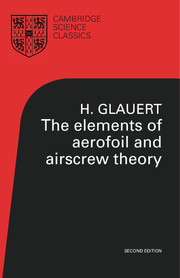Book contents
- Frontmatter
- PREFACE
- PREFACE TO SECOND EDITION
- Contents
- REFERENCES
- Chap. I Introduction
- Chap. II Bernoulli's Equation
- Chap. III The Stream Function
- Chap. IV Circulation and Vorticity
- Chap. V The Velocity Potential and the Potential Function
- Chap. VI The Transformation of a Circle into an Aerofoil
- Chap. VII The Aerofoil in Two Dimensions
- Chap. VIII Viscosity and Drag
- Chap. IX The Basis of Aerofoil Theory
- Chap. X The Aerofoil in Three Dimensions
- Chap. XI The Monoplane Aerofoil
- Chap. XII The Flow round an Aerofoil
- Chap. XIII Biplane Aerofoils
- Chap. XIV Wind Tunnel Interference on Aerofoils
- Chap. XV The Airscrew: Momentum Theory
- Chap. XVI The Airscrew: Blade Element Theory
- Chap. XVII The Airscrew: Wind Tunnel Interference
- Appendix
- Bibliography
- Index
Chap. XVII - The Airscrew: Wind Tunnel Interference
Published online by Cambridge University Press: 01 June 2011
- Frontmatter
- PREFACE
- PREFACE TO SECOND EDITION
- Contents
- REFERENCES
- Chap. I Introduction
- Chap. II Bernoulli's Equation
- Chap. III The Stream Function
- Chap. IV Circulation and Vorticity
- Chap. V The Velocity Potential and the Potential Function
- Chap. VI The Transformation of a Circle into an Aerofoil
- Chap. VII The Aerofoil in Two Dimensions
- Chap. VIII Viscosity and Drag
- Chap. IX The Basis of Aerofoil Theory
- Chap. X The Aerofoil in Three Dimensions
- Chap. XI The Monoplane Aerofoil
- Chap. XII The Flow round an Aerofoil
- Chap. XIII Biplane Aerofoils
- Chap. XIV Wind Tunnel Interference on Aerofoils
- Chap. XV The Airscrew: Momentum Theory
- Chap. XVI The Airscrew: Blade Element Theory
- Chap. XVII The Airscrew: Wind Tunnel Interference
- Appendix
- Bibliography
- Index
Summary
A model airscrew rotating in a wind tunnel disturbs the uniform flow produced by the tunnel fan and causes variations of velocity which extend to a considerable distance from the airscrew. This flow is constrained by the presence of the tunnel walls and the uniform axial velocity V which occurs at a sufficient distance in front of the airscrew in the tunnel differs from that which would occur in free air. It is necessary therefore to determine an equivalent free airspeed V′, corresponding to the tunnel datum velocity V, at which the airscrew, rotating with the same angular velocity as in the tunnel, would produce the same thrust and torque. A theoretical solution of this problem can be obtained by extending the simple momentum theory to the case of an airscrew rotating in a wind tunnel. The equivalent free airspeed is defined as that which gives the same axial velocity through the airscrew disc as occurs in the tunnel, since this condition will maintain the same working conditions for the airscrew blades, provided the interference effects of the rotational velocity are negligible. The equivalent free airspeed for an airscrew in a closed jet wind tunnel is normally less than the tunnel datum velocity.
The assumption that there is no interference effect on the rotational velocity appears to be sound, but the representation of the interference effect by a change from the tunnel datum velocity to the equivalent free airspeed depends on the existence of the same axial velocity over the whole airscrew disc.
- Type
- Chapter
- Information
- The Elements of Aerofoil and Airscrew Theory , pp. 222 - 226Publisher: Cambridge University PressPrint publication year: 1983
- 1
- Cited by



